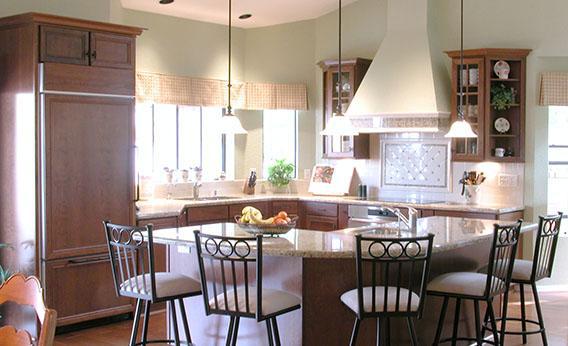Many pleasures await those who, like me, while away their downtime watching HGTV, the real estate and home improvement porn network. There is the thrill of finding hardwood under dingy carpet, for example, and the pathos of an asbestos discovery mid-gut job, not to mention the smugness one feels when witnessing entitled Americans stupidly demand central air conditioning in various European capitals on House Hunters International.
But perhaps most engrossing—for an apartment dweller, at least—is seeing how people with the money and space to thoroughly renovate their houses choose to use their resources. Many of their decisions delight me. An en suite in the attic? Creative! A mud room in place of a foyer? Functional! However, there is one distressingly popular design choice that has spread throughout HGTV’s stable of shows like black mold through a flooded basement, and I can no longer abet its growth by keeping silent. I’m talking about the baneful scourge that is the “open-concept kitchen.”
If you are not familiar with the insidious notion of crudely exposing your kitchen to the dining area and beyond (usually with only a squat “island” guarding the living spaces from the cabinets and appliances that tower behind it), you are lucky indeed. I’m all too familiar with the lies the open concept evangelists have force-fed us from their gleaming, granite countertops: It’s ideal for entertaining! You can chat with the girls and chop onions at the same time! You can monitor your children or watch your favorite programs while whipping up some homemade ravioli! The open concept propaganda machine knows no shame.
First, let’s talk about entertaining, an activity that HGTV homebuyers and renovators value highly, as a rule. I have been throwing dinner parties for four to 10 people for years from my sturdy little galley-style set-up, and I have never craved more openness. In fact, having one’s kitchen quite separate from the dining and lounging areas (as mine is) brings with it a host of benefits. For one thing, no matter how careful your mise en place, cooking requires some amount of mess-making. Why force your guests to gaze upon your sullied pots and pans while they eat, when you could leave them in a separate space to deal with later? Moreover, part of the joy of cooking for guests is surprising them with the wonders you’ve prepared—if you can see me adding freshly browned mushrooms to my coq au vin, there will be no revelation at the table. And finally, I have never known a skilled home cook who could engage in sparkling conversation while also properly attending to his work. If your guests are incapable of entertaining themselves for a few minutes in the living room while you plate the first course, draft your partner or your most gregarious friend to open a bottle and get things rolling—it’s the least they can do in exchange for the free meal.
I fear, though, that this advice will be lost on partisans of the open-concept kitchen because, to be frank, I suspect that most of them are not actually doing much cooking or entertaining. If they were, they would know that sometimes in the course of preparing a meal, events occur that would be better kept … out of sight, such as when one burns the dickens out of one’s hand and promptly drops one’s darling lattice pie on the floor, shattering the Pyrex dish and triggering a mild panic attack. Such mishaps do not an elegant vista make. And really, it’s vistas—rather than actual cooking—that drive the misguided psychological yearning of the open-concept proponent. We live in a culture that has been trained by the Food Network to view cooking—literally, to observe it like spectators—as a neat, graceful process during which the cook can calmly chat and blow kisses to Jeffrey while not missing a beat. This, I don’t have to point out to a real cook, is not reality, suggesting that open-concept kitchens are just another symptom of the fact that while many Americans are interested in cooking, few actually ever do it.
Call me old-fashioned, but the aim of a good dinner host should not be to show off his knife skills to a captive audience from a gaudy stage. Rather, with precision of focus and purity of heart, he should strive to honor his guests through the sheer quality of his cooking, thinking of himself and his comfort only after the work is finished. This, in the end, is the fundamental truth that open-concept kitchens try to cover with fancy backsplashes: As a home cook, you will spend more time as a drudge than as a captivating raconteur or a master of ceremonies—and good drudges, as we know from Downton Abbey, keep their work out of sight.
As for those who would argue that open-concept kitchens let busy parents keep an eye on their children, I’ll defer to this mother, who became disillusioned with her airy renovation once the little ones no longer required constant supervision. Though I am childless, it makes perfect sense to me that as increasingly self-sufficient cherubs discover children’s programming and other noisy joys, parents will crave a certain amount of division in their lives, leading to a newfound appreciation for walls. My sincere wish for all parents—and nonparents—is the airy freedom that can only come from closing a door.
